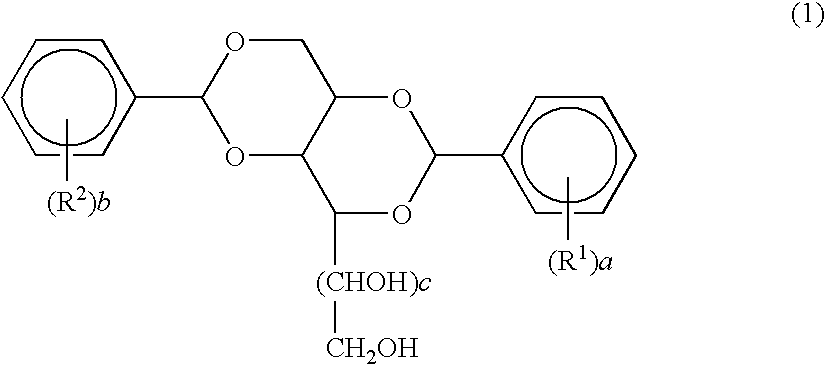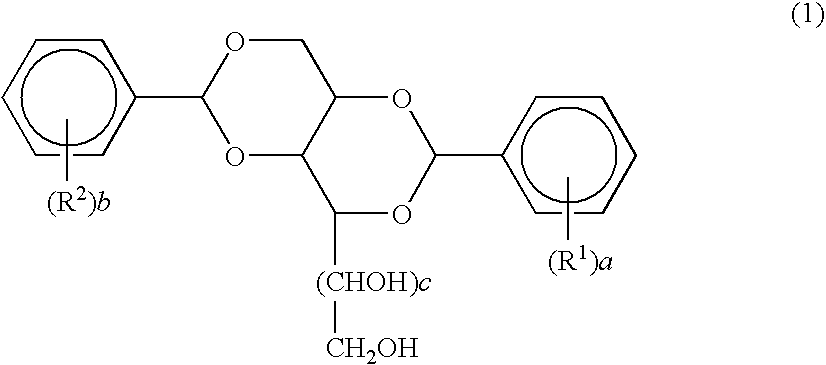Agent for suppressing transfer of odor and taste originating from a diacetal a diacetal composition comprising the agent for suppressing transfer of odor and taste a polyolefin nucleating agent comprising the composition a polyolefin resin composition and a molded product comprising the nucleating agent
a technology of diacetal and nucleating agent, which is applied in the direction of disinfection, water installations, lavatory sanitory, etc., can solve the problems of diacetal composition, diacetal composition, and inability to substantially affect the clarity of the resulting polyolefin resin molded product, so as to suppress the generation of aldehyde, reduce the amount of aldehyde generation, and suppress the transfer of odor and taste
- Summary
- Abstract
- Description
- Claims
- Application Information
AI Technical Summary
Benefits of technology
Problems solved by technology
Method used
Image
Examples
examples
[0260] The present invention will now be described in detail with reference to examples and comparative examples, but the present invention is not limited to or by these examples.
examples 1-5
[0261] 1,3:2,4-di(p-methylbenzylidene)sorbitol (hereinafter referred to as “Me-DBS”) and an alcohol or 12-hydroxystaric acid shown in Table 1 were stirred for one hour in methanol (weighing as 6 times as Me-DBS) under reflux to give a mixture in a white paste form. Then methanol was removed under reduced pressure, dried in a vacuum drier for one hour under the pressure of 133 Pa at a temperature of 80° C., to obtain a powdery sample (hereinafter referred to as “Me-DBS composition”).
[0262] To 100 weight parts of an isotactic random polypropylene resin with an ethylene content of 3.0 wt % (MFR=20 g / 10 minutes; hereinafter referred to as “r-PP”), were added 0.2 weight part of the Me-DBS composition, 0.05 weight part of tetrakis[methylene-3-(3,5-di-tert-butyl-4-hydroxyphenyl)propionate]methane (trade name “Irganox 1010”, made by Ciba Specialty Chemicals) and 0.05 weight part of calcium stearate, and these components were blended in a Henschel mixer. Then the mixture was melt kneaded us...
examples 6-27
[0275] Evaluation was conducted in the same manner as in Examples 1-5, except that fatty acid alkali metal salts, sulfuric ester salts and amines were employed in the amounts shown in Tables 2 and 3 in addition to the alcohols or 12-hydroxystearic acid shown in Tables 2 and 3. The results are shown in Tables 2 and 3.
[0276] In the diacetal compositions shown in Tables 2 and 3, the amount of component (B) and component (C) are expressed as a percentage (% by weight) based on the total amount of components (A) and (B). Accordingly, the percentage of component (A), MA (wt %), can be calculated as follows: MA=100−(MB+MC), wherein MB is the percentage of component (B) (wt %) and MC is the percentage of component (C) (wt %), with the proviso that MC=0, if component (C) was not used. The same applies to the following Tables 4 and 5.
TABLE 2Odor evaluationDiacetal compositionCrys-Injection-moldedCom-tallizationHazePelletproductAldehydeTasteponentAmountComponentAmounttemp.valueDryDryWetgene...
PUM
| Property | Measurement | Unit |
|---|---|---|
| weight ratio | aaaaa | aaaaa |
| weight ratio | aaaaa | aaaaa |
| weight ratio | aaaaa | aaaaa |
Abstract
Description
Claims
Application Information
 Login to View More
Login to View More - R&D
- Intellectual Property
- Life Sciences
- Materials
- Tech Scout
- Unparalleled Data Quality
- Higher Quality Content
- 60% Fewer Hallucinations
Browse by: Latest US Patents, China's latest patents, Technical Efficacy Thesaurus, Application Domain, Technology Topic, Popular Technical Reports.
© 2025 PatSnap. All rights reserved.Legal|Privacy policy|Modern Slavery Act Transparency Statement|Sitemap|About US| Contact US: help@patsnap.com



